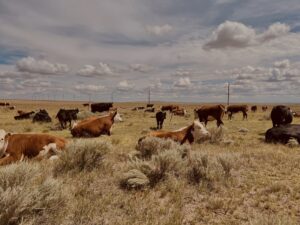Another Ranch, Another Way
#bfrdpwy #aginternship #RightRisk

Due to a land use conflict at my host ranch, my internship there was cut short, but I was able to finish my last two weeks on the Nelson Ranch. With changing ranches, it was interesting to see the differences between the two ranches. The biggest difference is how the Nelson ranch keeps records. At the Nelson ranch they keep books with all the numbers for cow and calf pairs, my original host ranch did not do this. The Nelson Ranch keeps track of the pairs because that’s just the way it has been done for years. They also calve in late January early February and they calve in barns and people are always out there doing nightly checks. So, when a calf is born there is someone right there able to check up on the pair and match them and tag them. Because of their constant presence, they are able to match pairs and document the lineage of the different cows and have a rough idea of which bull bred the cow.
From what I understood on the Robinson Ranch, and heard from the ranch hand I worked with, was that in the past the family members who owned and ran cattle and sheep on that land used to keep track of their cow/calf pairs. Now with the current family running the cattle, they don’t have the time or energy to keep track of pairs. The way they run the calving is to let the cows have a natural birth. What they do is they breed their cows in a very short period time during August for only about 20-30 days, starting at the beginning of the month. Then they birth late April to early May. Mr. Butler wants the cows to be able to have low stress and they match the calving up with when the antelope start birthing. The only time the family intervened was if there was a complication with the birth process or a calf was not progressing well. Due to a different approach to the birthing process, the Robinson’s would have a more difficult time tracking cow/calf pairs.

A problem that we faced this week at the ranch was pink eye. Since the Nelson Ranch runs Herefords, there is a higher chance for them to have pink eye, unlike at the Robinson Ranch that ran Black Angus. With Black Angus it is more unusual for them to have pink eye. The susceptibility to pink eye comes from the pigmentation of the skin on their face. The Herefords have a lighter pigmentation and are more susceptible to having pink eye.
An area I would challenge at the Nelson Ranch would be their rangeland management practices. I think that especially with the drought that has taken over this summer and with the ever-growing problem of Cheatgrass, and noxious weeds they should look into a better plan to conserve more of their grass especially when drought occurs. Something that I plan on doing is to look into their current rangeland management practices and have a conversation to see if they have any plans to changing it or leaving it the way it is.
Submitted by: Mckenna McGraw
Edited by: GrowinG Internship Team

